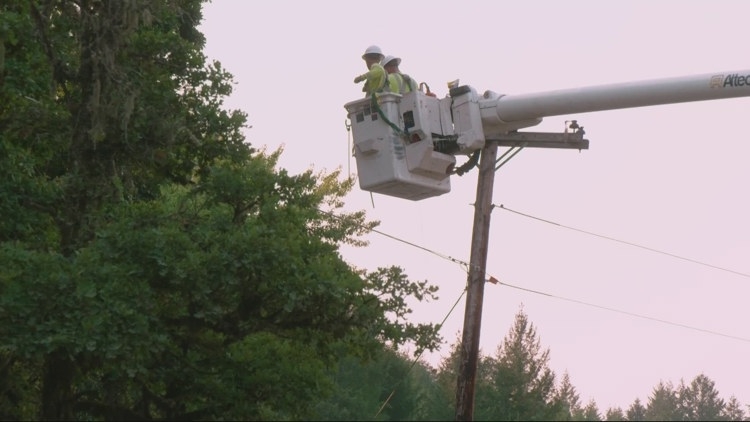

Published on: 07/16/2025
This news was posted by Oregon Today News
Description
In 2023, Eriby Rosen was determined to attend Portland Community College. The company she worked for had folded, leaving her without a job. That left an opening for her to switch careers and get into a higher-paying job as an accountant.
The only thing holding her back was finding affordable child care for her 18-month-old son, Judah, while she went back to school.
Rosen’s husband couldn’t care for their child because he works full-time. They also didn’t qualify for any federal or state child care subsidies, because they earned just over the income limits for the safety net programs they found.
“We don’t qualify for SNAP. We don’t qualify for WIC. We don’t qualify for Head Start,” Rosen said. “But we certainly are not making enough to pay $2,300 a month for child care — on top of [college] tuition and books.”
But there was a saving grace for Rosen. She learned that PCC offers child care financial assistance to students through a federal grant known as Child Care Access Means Parents in School, or CCAMPIS. The grant pumped more than $2 million into half a dozen child care programs operating within Oregon’s colleges and universities in 2023. Thanks to this funding, nearly all the cost of full-time care for Rosen’s son was covered while she attended school.
“It was monumental.” Rosen said. “Because of this, I was able to go back to school.”
But parenting students in the future may not get the same opportunity as Rosen.
The Trump administration proposed eliminating the CCAMPIS grant in its budget proposal for next year, arguing the program is redundant. The proposal – which is separate from the recently signed tax and spending bill – is part of a larger effort from the administration to rein in what it considers wasteful spending. Those moves include shrinking the U.S. Department of Education and shifting the responsibility of social support back to states.
Higher education advocates say getting rid of this funding will chip away at college access and affordability for student parents, ultimately hurting state economies and hindering workforce goals.
Who are parenting college students?
Student parents are a sizable population of college students.
More than three million college undergraduate students across the U.S. are parents, according to an analysis from the Student-Parent Action through Research Knowledge, or SPARK, Collaborative. They make up about 20% of all undergraduates.
In Oregon, about one in every five undergraduate students is a parent, too, according to estimates compiled by the Institute for Women’s Policy Research.three-quarters

Student parents are overwhelmingly women, people of color and the first in their families to attend a college or university, according to research by the SPARK Collaborative. Just over half are enrolled in community colleges. And although nearly three-quarters of these students juggle work with parenting and school, they also tend to be bookish.
“Student parents are really strong, academically,” said Theresa Anderson, a senior fellow at the nonpartisan research nonprofit Urban Institute who studies parenting college students.
“They actually get grades similar to, if not higher than, non-parenting students, but they are much less likely to complete a degree or credential,” Anderson said.
Just half of this student population are able to graduate with a degree in six years. That’s about 14 percentage points lower than their peers, according to the National Center for Education Statistics.
Anderson said these student parents have low graduation rates because they face several challenges – and finding affordable and high-quality care for their kids is chief among them.
Limited support
At both the state and federal levels, resources to support parenting students are limited.
The CCAMPIS grant, administered by the U.S. Department of Education, is the only federal grant aimed specifically at parenting college students.
Funds don’t go directly to students. Instead, colleges and universities apply and then use the money to help cover costs for their own child care centers or to pay for child care vouchers.

The only federal requirement for students is that they be eligible for Pell Grants, the U.S. Education Department’s largest form of student financial aid for low-income families. Income thresholds for Pell Grants are often higher than for federal safety net programs like Medicaid, Supplemental Nutrition Assistance Program or Head Start.
In theory, the CCAMPIS grant’s more expansive eligibility requirements should make it more accessible. But childcare and higher education advocates say the competitive program is underfunded and already lacks the resources to meet students’ child care demands.
“There aren’t very many solutions to child care costs these days, even though there’s such a huge need,” said Stephanie Hinkle, who leads PCC’s women and family services.
Oregon also offers some support to parenting students.
The Oregon Student Child Care Grant helps some eligible students cover a portion of child care costs. Nearly 450 people applied for the state grant program last school year, but due to high demand, only 22% of applicants were awarded the grant.
Oregon also expanded eligibility for its subsidized childcare program in 2023 to include students in college. But the program, known as Employment Related Day Care, has been plagued by long wait lists and chronic underfunding from state lawmakers.
Investing in parenting students pays off
When students have access to child care, it makes it easier to attend classes, study and graduate on time. A report published in 2021 showed that community college students who received child care assistance had both higher retention and graduation rates.
At PCC, nearly all of the students benefiting from the CCAMPIS grant from the past three years have either graduated, successfully transferred to university or moved on to other job training opportunities, according to a college spokesperson.
Rosen is one of them. She graduated from PCC with an associate’s degree in accounting last month. She plans on attending Portland State University this fall, with the goal of obtaining a liberal arts bachelor’s degree. She said her two years at PCC, with child care costs almost completely paid for, has been transformational.
“I think people often forget what community college is for: It’s for going back to school and getting people job ready,” said Rosen, who now works as an accountant at Oaks Amusement Park. “I was able to get a job in accounting just from those two years.”

This support also benefits students’ children.
“When you help parents complete an education, you see intergenerational impacts on their kids’ outcomes, both in their academic outcomes and in their workforce and earnings outcomes,” Anderson said. “Even short term, you see impacts on kids’ reading and math scores.”
State economies benefit too. A 2024 return-on-investment analysis co-authored by Anderson found that providing additional support for student parents could drastically increase degree attainment. More people with credentials would lead to more people with higher-paying jobs, a wealthier tax base and less strain on public benefit systems.
But the social and economic benefits that come with investing in student parents are in jeopardy if federal lawmakers follow through on Trump’s proposed budget.
Lack of child care ‘hurts us all’
Trump’s 2026 budget calls for drastic cuts to the Department of Education. It’s part of a wider effort to cut programs that do not align with his administration’s policies. Congress is working to pass the budget by Oct. 1, a deadline frequently missed by lawmakers.
The $75 million CCAMPIS grant is just one higher education program focused on increasing college access that could be cut. Republican budget writers say the grant is “unaffordable and duplicative,” and suggest that students can instead access subsidized child care through the Child Care Development Block Grant or that colleges could pay for students’ childcare needs.
But for Anderson, this logic doesn’t square in practice.
“The Child Care Development Block Grant is not specifically for students,” Anderson said. The federal block grant is a major funder of Oregon’s subsidized child care program, which currently has a waitlist of more than 12,000 families.
“Many times students have a very hard time accessing those state subsidies because they’re limited, not everyone who qualifies gets it — by a long shot,” Anderson said.
Hinkle, the PCC head of women and family services, disagrees with the proposal to shift the responsibility of child care costs onto cash-strapped higher education institutions.
“That colleges, who are shrinking budgets for a lot of reasons, are expected to take up a very astronomical budget item is unrealistic,” Hinkle said.
Hinkle doesn’t think PCC’s child care centers would disappear if the CCAMPIS grant is no more. But she said its elimination would result in a “painful shrinking” of the affordable child care services the college offers to students. The grant currently pays for 28 full-time child care slots at PCC. Student parents pay just $50 per month out-of-pocket.
Overall, Hinkle believes the grant’s elimination would create even more barriers for low-income families, especially those seeking a higher education. Parenting students won’t be able to stay in school.
“We’re harming not only these families and the next generation of students, but the whole local economy as well,” Hinkle said. “It hurts us all.”
Rosen believes the extra support received through the grant has allowed her to climb the economic ladder. She’s making more money and contributing to the local and state economy more. And she’s not upset that she’s in a higher tax bracket now.
“Taking [the grant] away limits someone’s future contribution back to society through paying taxes. That’s the economic fabric that builds America,” Rosen said. “You have to give people a chance to succeed.”
News Source : https://www.opb.org/article/2025/07/16/child-care-trump-budget-eliminate-college-access-oregon-parent-students/
Other Related News
07/16/2025
After months of procrastination and dread Seattles main traffic event of 2025 is finally u...
07/16/2025
Enhanced Powerline Safety Settings reduce the risk of fire ignitions from electrical equip...
07/16/2025
The cyclist was struck Sunday evening and died the following morning The driver was arrest...
07/16/2025











